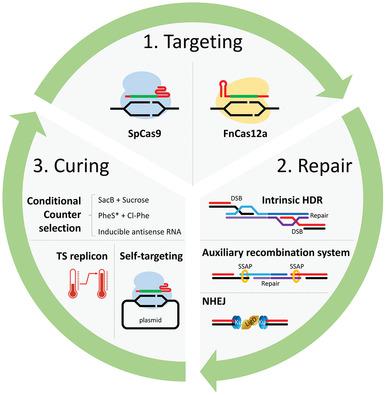当前位置:
X-MOL 学术
›
Small Methods
›
论文详情
Our official English website, www.x-mol.net, welcomes your
feedback! (Note: you will need to create a separate account there.)
Strategies for Developing CRISPR‐Based Gene Editing Methods in Bacteria
Small Methods ( IF 10.7 ) Pub Date : 2019-11-19 , DOI: 10.1002/smtd.201900560 Zhaowei Wu 1 , Yujue Wang 1 , Yifei Zhang 1 , Weizhong Chen 1 , Yu Wang 1 , Quanjiang Ji 1
Small Methods ( IF 10.7 ) Pub Date : 2019-11-19 , DOI: 10.1002/smtd.201900560 Zhaowei Wu 1 , Yujue Wang 1 , Yifei Zhang 1 , Weizhong Chen 1 , Yu Wang 1 , Quanjiang Ji 1
Affiliation

|
Gene editing is a fundamental technique for the identification of the linkages from genetic determinants to significant biological phenotypes, and the engineering of industrial strains to produce fine chemicals. Recently, the primitive bacterial immunity systems, clustered regularly interspaced short palindromic repeat (CRISPR)‐Cas systems, have been engineered as programmable nucleases to deliver double‐strand breaks (DSBs) at user‐defined loci. The DSB is repaired via either homology‐direct repair or the non‐homologous end joining pathway, generating a mutant in various organisms, and leading a revolution in the field of gene editing. This paper reviews the structural and molecular details of CRISPR‐Cas systems, describing their applications and challenges of genome targeting in bacterial cells. Moreover, the DSB repair pathways in bacteria are summarized and a guideline for selecting repair machines and maximizing the recombination efficiency is presented. In addition, the plasmid curing approaches in bacteria are outlined for iterative gene editing or downstream biological applications. Furthermore, CRISPR‐based transcriptional regulation, base editing, and transposition are also introduced. Finally, this paper prospects the future directions for improving CRISPR‐based gene editing methods in bacteria.
中文翻译:

在细菌中开发基于CRISPR的基因编辑方法的策略
基因编辑是一种基本技术,可用于识别从遗传决定因素到重要的生物表型的联系,以及用于生产精细化学品的工业菌株的工程设计。最近,原始的细菌免疫系统,规则间隔的短回文重复序列(CRISPR)-Cas系统被聚类为可编程核酸酶,可在用户定义的基因座处提供双链断裂(DSB)。通过同源直接修复或非同源末端连接途径修复DSB,从而在各种生物体中产生突变体,并引领了基因编辑领域的一场革命。本文回顾了CRISPR-Cas系统的结构和分子细节,描述了它们在细菌细胞中的应用和基因组靶向的挑战。而且,总结了细菌中DSB的修复途径,并提出了选择修复机器和最大程度提高重组效率的指南。另外,概述了细菌中的质粒固化方法,用于迭代基因编辑或下游生物学应用。此外,还介绍了基于CRISPR的转录调控,碱基编辑和转座。最后,本文展望了改进细菌中基于CRISPR的基因编辑方法的未来方向。和换位也被介绍。最后,本文展望了改进细菌中基于CRISPR的基因编辑方法的未来方向。和换位也被介绍。最后,本文展望了改进细菌中基于CRISPR的基因编辑方法的未来方向。
更新日期:2019-11-20
中文翻译:

在细菌中开发基于CRISPR的基因编辑方法的策略
基因编辑是一种基本技术,可用于识别从遗传决定因素到重要的生物表型的联系,以及用于生产精细化学品的工业菌株的工程设计。最近,原始的细菌免疫系统,规则间隔的短回文重复序列(CRISPR)-Cas系统被聚类为可编程核酸酶,可在用户定义的基因座处提供双链断裂(DSB)。通过同源直接修复或非同源末端连接途径修复DSB,从而在各种生物体中产生突变体,并引领了基因编辑领域的一场革命。本文回顾了CRISPR-Cas系统的结构和分子细节,描述了它们在细菌细胞中的应用和基因组靶向的挑战。而且,总结了细菌中DSB的修复途径,并提出了选择修复机器和最大程度提高重组效率的指南。另外,概述了细菌中的质粒固化方法,用于迭代基因编辑或下游生物学应用。此外,还介绍了基于CRISPR的转录调控,碱基编辑和转座。最后,本文展望了改进细菌中基于CRISPR的基因编辑方法的未来方向。和换位也被介绍。最后,本文展望了改进细菌中基于CRISPR的基因编辑方法的未来方向。和换位也被介绍。最后,本文展望了改进细菌中基于CRISPR的基因编辑方法的未来方向。











































 京公网安备 11010802027423号
京公网安备 11010802027423号